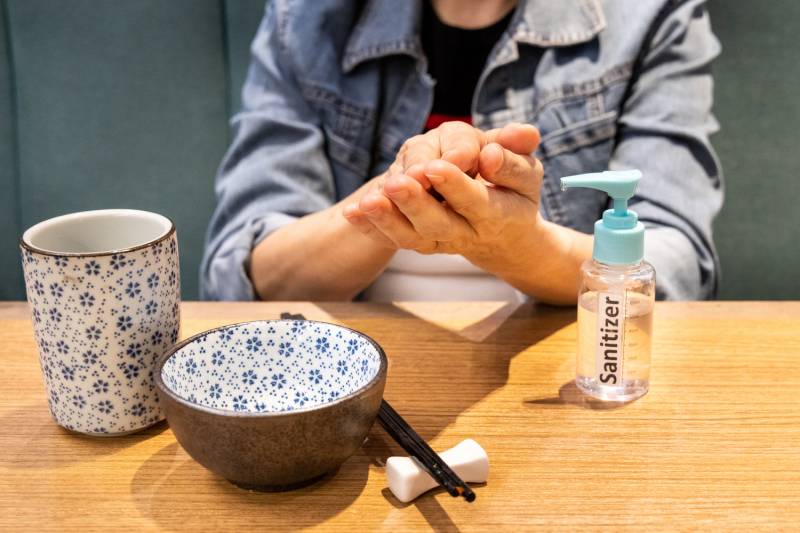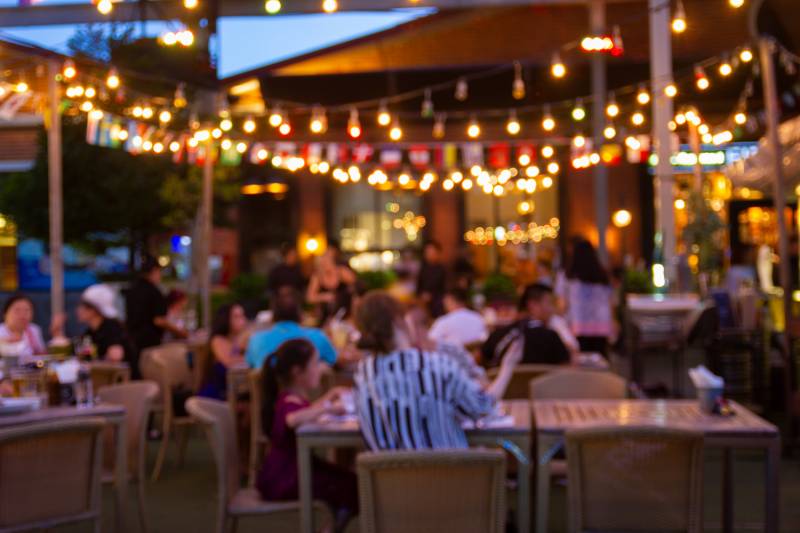
As Bay Area restaurants reopen, there is still a lot of uncertainty about how to keep patrons and workers safe. And although the CDC recommends takeout, delivery, curbside pick-up and drive-through services to mitigate the spread of COVID-19, many Bay Area residents are eager to dine out at their favorite eateries again.
There’s a new, pandemic-era social contract, the first rules of which are maintaining social distancing and wearing a mask. Understanding the risk before deciding to eat at a restaurant is another. Everyone’s comfort level is different, and it’s important to communicate your limits politely and effectively. It’s OK, for instance, to tell someone from a safe distance that you’d like a little bit more space while waiting in line.

It seems obvious, but do not go to restaurants (or out at all) if you’re feeling ill, have been in contact with someone who is, or live with someone who is high-risk. “Everything’s a little bit of a balance of how much risk people are willing to tolerate,” says UCSF infectious disease specialist Dr. Sarah Doernberg.
With that in mind, we’ve put together these guidelines to better your dining experience for both your party and your servers.
Wear Your Mask

On June 18, California Gov. Gavin Newsom mandated wearing masks in high-risk public spaces, or places where it is difficult or impossible to maintain social distancing. Most restaurants in the Bay Area fall under that category.
A new study from The Proceedings of the National Academy of Sciences of the USA found that mask usage was linked to decreased COVID-19 infection rates. The CDC recommends wearing a cloth face covering because it traps respiratory secretions before they spread to the environment. So wear your mask as much as possible.
Wear your mask at your table, while waiting in line, between bites, while chatting with your dining companion and while giving your order to your server—at all times except while eating or drinking. Also, try not to touch your mask too much or adjust it unless you’re eating. (Also, wash your mask regularly).
Bring Hand Sanitizer and Wipes

Just wearing a facemask isn’t enough. CDC guidelines require employees to wash their hands frequently and use hand sanitizer that contains at least 60% alcohol. Diners should follow similar precautions for their own safety, as well as that of fellow customers and their servers. “We have suggested to resturaunterus to add sanitizer bottles at the table,” says Larry Lynch, SVP of science and technology at the National Restaurant Association.
Don’t Bring Your Own Silverware

Lynch says that, because of FDA guidelines, the utensils and dinnerware at the restaurant are probably cleaner than what you have at home.
Where to Put What

Doernberg says storing your mask in a clean, dry place while you’re not using is the most hygienic practice. Consider bringing a brown bag or a Ziploc.
Pick Up the Phone
“There’s nothing wrong with calling before you go,” Lynch says. You can ask the restaurant what their protocols are and if they’re willing to make further adjustments according to your concerns. If not, Lynch says, you probably shouldn’t go to that restaurant at this time.
Stay Outdoors

As of June 12, San Francisco restaurants that provide in-house service have to be outdoors. While Napa County allows for both indoor and outdoor dining, other Bay Area Counties, like Alameda, San Mateo and Sonoma, have the same guidelines as SF. This is, in part, because of natural ventilation. Doernberg says that unlike indoor dining, air isn’t getting recirculated and viral particles can move away more quickly outdoors.
Keep It Small
Now is not the time to start planning a huge birthday party. “That’s really in the rules that you can only dine right now with people in your household,” says Laurie Thomas, the executive director of the Golden Gate Restaurant Association. “You can’t go out to dinner with friends.” She adds that a table should have no more than six customers from the same household.
Some other tips on keeping it small: etiquette specialist Syndi Seid of Advanced Etiquette recommends asking for one server for your table. You can also try to keep finished dishes on one side of the table for your server to pick up.
Avoid Peak Times

While that coveted 7pm dinner slot might sound enticing, the more people you sit around, the higher your risk of contracting coronavirus. It’s OK to ask the restaurant when peak times are too.
Make a Reservation

This is commonplace in Bay Area fine dining, but in this new normal, making reservations helps restaurants keep track of their numbers. It also helps you avoid lines, limiting your exposure to other people. Many places are opting for a text system, says Lynch, where restaurants will text diners when their table is ready.
Welcome Temperature Checks

Seid says that restaurants doing this are top choices for her: “It shows how much they care about keeping everyone safe at all times.”
Order Once and Bus Less

Lynch recommends putting in your full meal order (drinks, appetizers, entrées and desserts) in one go so your server doesn’t have to come back more times than needed. He also suggests requesting that dishes get bussed only after you’ve finished your meal. “We know that the table may be a little messier than what you’re used to,” he says, adding that bussing less frequently decreases the amount of contact with your server.
Be Selfish
Even if you’re living with your dining companion, Doernberg says that sharing food still poses a risk. That includes not sharing ketchup bottles and utensils. People within a family or household have different risks for contracting COVID-19, Doernberg adds. For Doernberg, who sees patients every day, the level of potential exposure is much greater than for her husband, who works from home. “If I bring my risk and I’m sharing food and things that may expose him to risk that he otherwise wouldn’t have, it’s taking measures to not spread things between household members,” she says.
Keep the Bottle at the Table

Get a pitcher of water or a bottle of wine (if you’re planning on more than one glass) to avoid having your server come around more times than necessary.
Use Your Napkin
“The guidelines while dining are pretty much the same in terms of your table manners,” says Seid. “I think at the top of that list, perhaps, is don’t talk with your mouth open.” Use your napkin if you’re going to sneeze, burp, cough or hiccup. Use a knife and fork. Keep your hands on the table. These are all guidelines that existed before coronavirus, and they’re just as important now.
Be Patient
With new requirements from the CDC, state and city on top of fairly strict FDA guidelines, restaurant service can take longer than usual, and that’s OK.
Keep It Short
As much as you might want to spend four hours dining al-fresco, it might not be advisable from a health and politeness perspective. Length of exposure is linked to increased risk for contracting coronavirus. And with restaurants scrambling to meet demand, keeping your dining experience as short as possible is the way to go. Seid recommends an hour or less.
Go Cashless If You Can

Some establishments have foregone cash altogether in an attempt to limit exchange of germs, so be prepared to use your card over your dollar bills. (However, state law still requires businesses to accept payments in cash.) Doernberg recommends to use touchless payment whenever possible. If using a credit card, consider wiping it down before and after handing it over.
Don’t forget to bring your own pen if you’re required to sign the bill, and sanitize it after signing.
Give Them Your Contact Info
If you made a reservation, chances are that the restaurant has a way of contacting you because you gave an email or phone number. If you didn’t, the restaurant may ask for your information in case they learn someone who was at the restaurant came into contact with or contracted COVID-19.
Bathroom Etiquette

From door handles to airborne particles and trying to maintain social distancing while waiting in line for the bathroom, there’s a lot to keep in mind. If we’re being honest, it’s probably best to hold it if you can.
If you can’t, some tips include: Wear your mask to and inside the bathroom, close the lid (if possible) when flushing, wash your hands and try to avoid touching the door handles (or sanitize them after you do). Here’s a guide on public restrooms from William Petri from the University of Virginia.
“It’s another area where we have partial information for, but no real information,” says Doernberg. “We know that you can detect the virus in feces. We don’t know if this is the live virus or for how long it stays in the air after you flush the toilet.” She says that it’s probably a pretty low risk to use the bathroom, even if someone who has had the virus has used the toilet before you, “as long as you really wash your hands.”
Tip Generously

Dining out, especially right now, is a privilege and very weird to navigate. Supporting your favorite local eatery could help it stay in business. But opening to dine-in service also puts everyone working there at risk. And yet, before outdoor dining, many restaurant workers were either laid off or furloughed. Many are returning to work to avoid losing their benefits. A generous tip might not fully make up for that, but it is something. It’s a recognition, a thank you of sorts.

Appreciate the suggestions. I also wear a neck piece for glasses with my COVID vaccination record, laminated (like employment entrance badge) as a courtesy to employees of whatever.